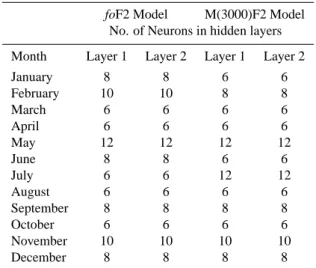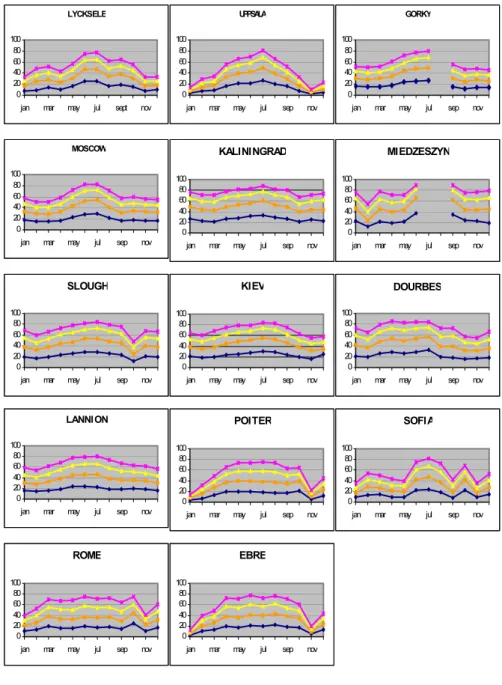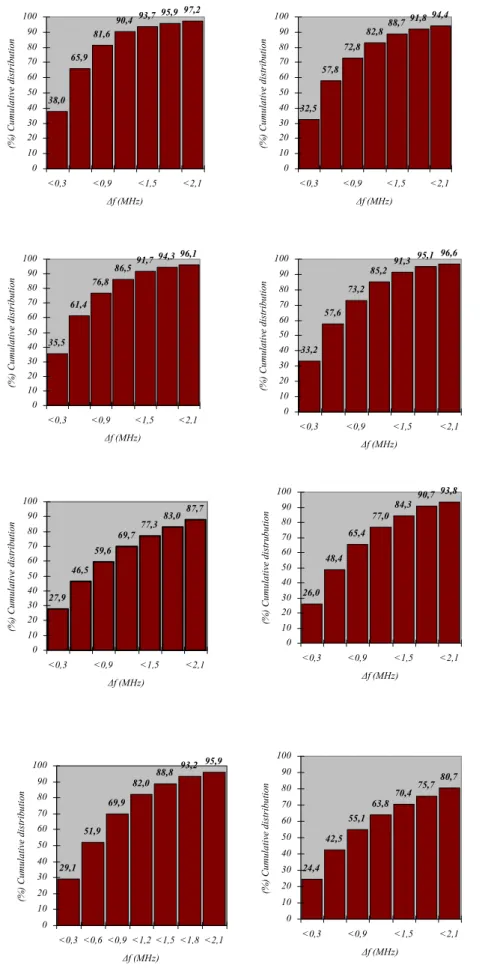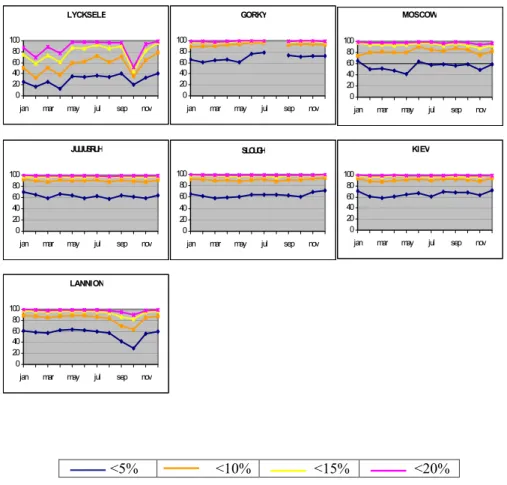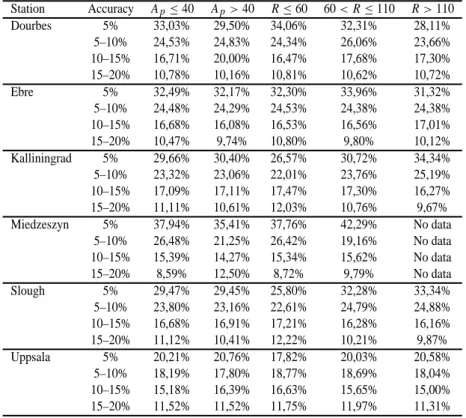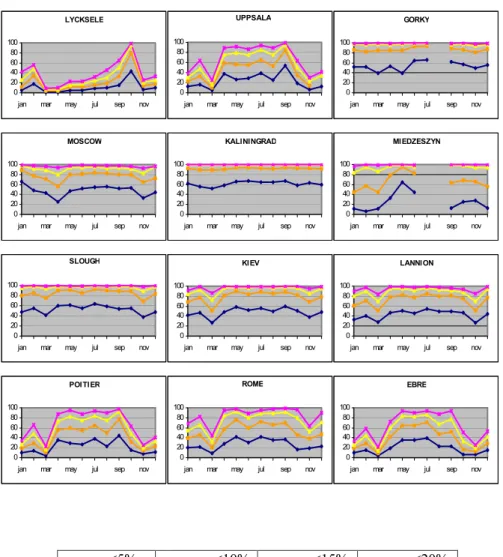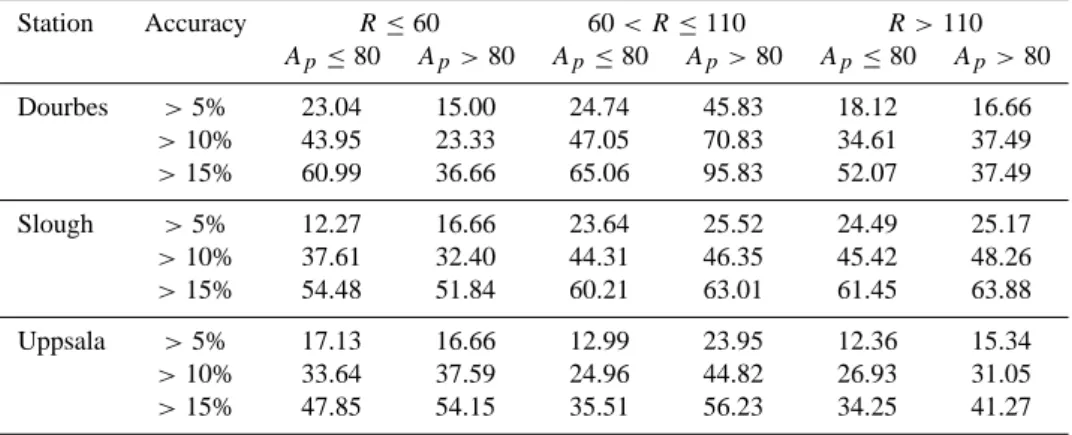HAL Id: hal-00302154
https://hal.archives-ouvertes.fr/hal-00302154
Submitted on 1 Jan 2002
HAL is a multi-disciplinary open access
archive for the deposit and dissemination of
sci-entific research documents, whether they are
pub-lished or not. The documents may come from
teaching and research institutions in France or
abroad, or from public or private research centers.
L’archive ouverte pluridisciplinaire HAL, est
destinée au dépôt et à la diffusion de documents
scientifiques de niveau recherche, publiés ou non,
émanant des établissements d’enseignement et de
recherche français ou étrangers, des laboratoires
publics ou privés.
station modeling and regional mapping of the foF2 and
M(3000)F2 ionospheric characteristics
T. D. Xenos
To cite this version:
T. D. Xenos. Neural-network-based prediction techniques for single station modeling and regional
mapping of the foF2 and M(3000)F2 ionospheric characteristics. Nonlinear Processes in Geophysics,
European Geosciences Union (EGU), 2002, 9 (5/6), pp.477-486. �hal-00302154�
Nonlinear Processes in Geophysics (2002) 9: 477–486
Nonlinear Processes
in Geophysics
c
European Geosciences Union 2002
Neural-network-based prediction techniques for single station
modeling and regional mapping of the foF2 and M(3000)F2
ionospheric characteristics
T. D. Xenos
Aristotelian University of Thessaloniki, Dept of Electrical and Computers Eng., 54006 Thessaloniki, Greece Received: 20 February 2002 – Revised: 19 June 2002 – Accepted: 26 June 2002
Abstract. In this work, Neural-Network-based single-station hourly daily foF2 and M(3000)F2 modelling of 15 European ionospheric stations is investigated. The data used are neu-ral networks and hourly daily values from the period 1964– 1988 for training the neural networks and from the period 1989–1994 for checking the prediction accuracy. Two types of models are presented for the F2-layer critical frequency prediction and two for the propagation factor M(3000)F2. The first foF2 model employs the E-layer local noon
calcu-lated daily critical frequency (foE12) and the local noon
F2-layer critical frequency of the previous day. The second foF2 model, which introduces a new regional mapping technique, employs the Juliusruh neural network model and uses the
E-layer local noon calculated daily critical frequency (foE12),
and the previous day F2-layer critical frequency measured at Juliusruh at noon. The first M(3000)F2 model employs the E-layer local noon calculated daily critical frequency (foE12),
its ±3 h deviations and the local noon cosine of the solar
zenith angle (cos χ12). The second model, which introduces
a new M(3000)F2 mapping technique, employs Juliusruh neural network model and uses the E-layer local noon cal-culated daily critical frequency (foE12), and the previous day
F2-layer critical frequency measured at Juliusruh at noon.
1 Introduction
The electron density height distributions of a single loca-tion find many applicaloca-tions both in scientific investigaloca-tion and in radio-system performance assessments over neighbor-ing paths. Moreover prediction of certain parameters, as for instance foF2 and M(3000)F2 is essential for planning HF propagation radio-links. These data may be given either from measurements or by theoretical calculations. In ionospheric prediction, single-station ionospheric models posses several advantages over the rest of the methods; their cost is very
Correspondence to: T. D. Xenos
(tdxenos@vergina.eng.auth.gr)
low, usually they are very simple to use and in the vicinity of the station they are considerably accurate. Therefore, a number of empirical single station models (SSM) have been produced for different stations and ionospheric parameters. The activity in this area has increased as a consequence of the COST-238 and COST-251 projects. Most of the mod-els are based on Fourier analysis (Alberca et al., 1999) or on polynomial fitting of different degree (Alberca et al., 1999; Kouris and Nissopoulos, 1994; Xenos, 1999). Several mod-elers introduce a second index or parameter, in addition to the solar or ionospheric index. Pancheva and Mukhtarov (1996) for instance use a parameter to determine the phase of the solar cycle that corresponds to the solar activity considered
and Sole (1998) uses the magnetic index Ap together with
the ionospheric index T . In most cases, foF2 is the mod-eled ionospheric characteristic, although other parameters – mainly foE and M(3000)F2 – have been modeled too.
Neural networks have been tried in single station mod-elling. Williscroft and Poole (1996) have attempted to predict
foF2 using as training parameters the number of the day and
the corresponding solar activity index, and the magnetic ac-tivity index for the period 1973–1993; the years 1989 (year of low solar activity) and 1995 (year of high solar activity) were excepted from the training and they were used for val-idation of the prediction. The average prediction deviation was of the order of 1.03 and 0.92 MHz respectively. Several attempts have been recently made to employ neural networks to one-hour ahead foF2 prediction (Altynay et al., 1997; Can-der et al., 1998). Neural Networks have been also been used in successfully temporal and spatial forecasting foF2 mod-els for four European stations with very rich past data sets (Kumulca eta al., 1997).
In the present work Neural Network based single-station hourly daily foF2 and M(3000)F2 modeling of 10 European ionospheric stations is investigated. Two types of models are tested or the F2-layer critical frequency and two for the prop-agation factor M(3000)F2. The first foF2 model employs the E-layer local-noon calculated daily critical frequency (foE12)
previ-L Y C K S E previ-L E 0 20 40 60 80 100
jan mar may jul sep nov
U P P S A L A 0 20 40 60 80 100
jan mar may jul sep nov
G O R K Y 0 20 40 60 80 100
jan mar may jul sep nov
M O S C O W 0 20 40 60 80 100
jan mar may jul sep nov
K A L I N I N G R A D 0 20 40 60 80 100
jan mar may jul sep nov
M I E D Z E S Z Y N 0 20 40 60 80 100
jan mar may jul sep nov
S L O U G H 0 20 40 60 80 100
jan mar may jul sep nov
K I E V 0 20 40 60 80 100
jan mar may jul sep nov
D O U R B E S 0 20 40 60 80 100
jan mar may jul sep nov
P O I T I E R 0 20 40 60 80 100
jan mar may jul sep nov
S O F I A 0 20 40 60 80 100
jan mar may jul sep nov
R O M E 0 20 40 60 80 100
jan mar may jul sep nov
E B R E 0 20 40 60 80 100
jan mar may jul sep nov
L A N N I O N 0 20 40 60 80 100
jan mar may jul sep nov
JULIUSRUH 0 20 40 60 80 100
jan mar may jul sep nov
<5% <10% <15% <20%
Fig. 1. Performance of the foF2 single station model for each ionospheric station.
ous day. The second foF2 model, which in fact introduces a new regional mapping technique, employs the Juliusruh neu-ral network model and uses the E-layer local noon calculated
daily critical frequency (foE12), and the previous day
F2-layer critical frequency measured at Juliusruh at noon. The first M(3000)F2 model employs the E-layer local noon calcu-lated daily critical frequency (foE12), its ±3 h deviations and
the local noon cosine of the solar zenith angle (cos χ12). The
second model, which also introduces a new M(3000)F2 map-ping technique, employs the Juliusruh neural network model and uses the E-layer local noon calculated daily critical
fre-quency (foE12), and the previous day F2-layer critical
fre-quency measured at Juliusruh at noon. The predicted values are compared to the corresponding measured data and the relative errors are calculated. In this stage, the predicted pe-riods were categorised according to the geomagnetic (with
respect to Ap) and solar (with respect to R) conditions into
two categories for the former, defining quiet and disturbed ionosphere, and three for the latter, describing low, medium and high solar activity. Depending on the type of data and on the month, the resulting correlation seems to vary from good to very good and what is more important, the results
T. D. Xenos: Neural-network-based prediction techniques 479
Table 1. Ionospheric stations used for modelling
Station Coordinates Dourbes 50.1 N, 4.6 E Ebre 40.8 N, 0.5 E Gorky 56.1 N, 44.3 E Juliusruh 54.6 N, 13.4 E Kaliningrad 54.7 N, 20.6 E Kiev 50.5 N, 30.5 E Lannion 48.8 N, 356.6 E Lycksele 64.7 N, 18.8 E Miedzeszyn 52.2 N, 21.2 E Moskow 55.5 N, 37.3 E Poitier 46.6 N, 0.3 E Rome 41.9 N, 12.5 E Slough 51.5 N, 359.4 E Sofia 42.7 N, 23.4 E Uppsala 59.8 N, 17.6 E
do not seem to be affected considerably by geomagnetic or solar conditions. Moreover, it is worth mentioning that the new mapping technique gives very promising results com-pared to other existing regional mapping techniques applied in the same area.
2 Methods
The data used in the models are hourly daily values of the F2-layer critical frequency (foF2) or of the propagation fac-tor M(3000)F2, depending on the availability, for the period 1964–1988 for training the neural networks and for the pe-riod 1989–1994 for checking the data prediction accuracy. The ionospheric stations and their positions are presented in Table 1. The characteristics of the neural networks employed are presented in Table 2b whereas in Table 2a the characteris-tics of the Neural Networks employed for the Juliusruh mod-els are given. All modmod-els employ the hourly-daily E-layer
critical frequency calculated at noon (foE12) (1) (Kouris,
1981)
foE4=(cos χ )1.2(1 + 0.0091 R)
(88 + 31 cos φ)(d−2)(cos χ12)(0.11−0.49 cos φ) (1)
where:
Table 2a. Juliusruh Neural network characteristics
foF2 Model M(3000)F2 Model No. of Neurons in hidden layers Month Layer 1 Layer 2 Layer 1 Layer 2
January 8 8 6 6 February 10 10 8 8 March 6 6 6 6 April 6 6 6 6 May 12 12 12 12 June 8 8 6 6 July 6 6 12 12 August 6 6 6 6 September 8 8 8 8 October 6 6 6 6 November 10 10 10 10 December 8 8 8 8
Table 2b. Neural network characteristics
Neural Network type Multilayer perceptron Training method Back-Propagation, Batching Method Optimization Adaptive learning rate parameter
and momentum constant Neural Network structure One input, two hidden, one output Activation functions tanh(x) for the hidden layers,
linear for the output Training end criterion Cross-validation method
foE is the E-layer critical frequency
R is the solar sunspot index
cos χ is the solar zenith angle cosine
cos χ12 is the solar zenith angle cosine at noon
d is the ratio of the Sun-Earth distance on
the fifteenth day of each month to the average value of the year
cos φ is the geographical latitude cosine
The characteristics of each model are presented in Table 3. The average therein deviations from the local noon foE are calculated as:
f0oE = (foE12−foEav)/foEav (2)
where: foEav= " P11 i=9foEi+P15i=13foEi # 6 (3) 3 Results
For each month and for the period 1989–1994 the observed and the corresponding estimated foF2 and M(3000)F2 hourly
UPPSALA 0 20 40 60 80 100
jan mar may jul sep nov
M O S C O W 0 20 40 60 80 100
jan mar may jul sep nov
M I E D Z E S Z Y N 0 20 40 60 80 100
jan mar may jul sep nov
L Y C K S E L E 0 20 40 60 80 100
jan mar may jul sept nov
L A N N I O N 0 20 40 60 80 100
jan mar may jul sep nov
S O F I A 0 20 40 60 80 100
jan mar may jul sep nov
R O M E 0 20 40 60 80 100
jan mar may jul sep nov
E B R E 0 20 40 60 80 100
jan mar may jul sep nov
K A L I N I N G R A D 0 20 40 60 80 100
jan mar may jul sep nov
D O U R B E S 0 20 40 60 80 100
jan mar may jul sep nov
G O R K Y 0 20 40 60 80 100
jan mar may jul sep nov
S L O U G H 0 20 40 60 80 100
jan mar may jul sep nov
P O I T E R 0 20 40 60 80 100
jan mar may jul sep nov
K I E V 0 20 40 60 80 100
jan may may jul sep nov
<5% <10% <15% <20%
Fig. 2. Performance of the foF2 mapping at each ionospheric station.
daily values were compared and the relative error was calcu-lated and distributed according to the achieved error to four categories, namely those of less than: 5%, 10%, 15% and 20%.
The results for the foF2 models are shown in Figs. 1 and 2 and for the M(3000)F2 models in Figs. 5 and 6. From Fig. 1 it can be seen that for the vast majority of the stations con-sidered, an accuracy higher than 5% is achieved in 20–40% of the cases, an accuracy higher than 10% in 40–60%, an
ac-curacy higher than 15% in 60–80%. Moreover, it has been shown that foE plays an important role in the performance of this model since in the northernmost stations (e.g. Lyck-selle) the accuracy is degraded in winter where the daytime duration is very short and hence foE cannot affect the model adequately. A closer look at Fig. 1 reveals a symmetry with characteristic accuracy degradation in the equinoxes and an increase in summer. This could be related to an enhancement in the foF2 variability during the spring and autumn months.
T. D. Xenos: Neural-network-based prediction techniques 481 38,0 65,9 81,6 90,4 93,795,9 97,2 0 10 20 30 40 50 60 70 80 90 100 <0,3 <0,9 <1,5 <2,1 ∆f (MHz) (%) Cumulativ e distribution 32,5 57,8 72,8 82,888,7 91,8 94,4 0 10 20 30 40 50 60 70 80 90 100 <0,3 <0,9 <1,5 <2,1 ∆f (MHz) (%) Cumulativ e distribution 35,5 61,4 76,8 86,591,7 94,3 96,1 0 10 20 30 40 50 60 70 80 90 100 <0,3 <0,9 <1,5 <2,1 ∆f (MHz) (%) Cumulativ e distribution 33,2 57,6 73,2 85,2 91,3 95,1 96,6 0 10 20 30 40 50 60 70 80 90 100 <0,3 <0,9 <1,5 <2,1 ∆f (MHz) (%) Cumulativ e distribution
Fig. 3. Performance of foF2 single
sta-tion model for Kiev and for January, March, June and November.
29,1 51,9 69,9 82,0 88,8 93,2 95,9 0 10 20 30 40 50 60 70 80 90 100 <0,3 <0,6 <0,9 <1,2 <1,5 <1,8 <2,1 ∆f (MHz) (% ) Cumulativ e distribution 26,0 48,4 65,4 77,0 84,3 90,7 93,8 0 10 20 30 40 50 60 70 80 90 100 <0,3 <0,9 <1,5 <2,1 ∆f (MHz) (%) Cumulativ e distrubution 27,9 46,5 59,6 69,7 77,3 83,087,7 0 10 20 30 40 50 60 70 80 90 100 <0,3 <0,9 <1,5 <2,1 ∆f (MHz) (% ) Cu mu la tiv e d istrib utio n 24,4 42,5 55,1 63,8 70,4 75,7 80,7 0 10 20 30 40 50 60 70 80 90 100 <0,3 <0,9 <1,5 <2,1 ∆f (MHz) (%) Cumulativ e distribution
Fig. 4. Performance of foF2 mapping
model for Kiev and for January, March, June and November.
L Y C K S E L E 0 20 40 60 80 100
jan mar may jul sep nov
G O R K Y 0 20 40 60 80 100
jan mar may jul sep nov
M O S C O W 0 20 40 60 80 100
jan mar may jul sep nov
K I E V 0 20 40 60 80 100
jan mar may jul sep nov
L A N N I O N 0 20 40 60 80 100
jan mar may jul sep nov
SLOUGH 0 20 40 60 80 100
jan mar may jul sep nov
JULIUSRUH 0 20 40 60 80 100
jan mar may jul sep nov
<5% <10% <15% <20%
Fig. 5. Performance of the M(3000)F2 single station model for each ionospheric station.
Table 3. Model inputs
foF2 foF2 M(3000)F2 M(3000)F2
SSM Mapping SSM Mapping
foE12 FoE12 foE12 foE12
foF212 odb foF212 odb f0oE foF212 odb
one day before one day before one day before
at Juliusruh at Juliusruh
cos χ12
(Kouris et al., 1998, 1999).
The results of the second model for F2, which is charac-terized as an electronic mapping model, are summarized in Fig. 2. From this figure, it can be seen that for the vast ma-jority of the stations considered, an accuracy higher than 5% is achieved in 10–20% of the cases, an accuracy higher than 10% in 10–40%, an accuracy higher than 15% in 10–60% of the cases whereas a better accuracy than 20% can be reached in 10–80% of the cases. The symmetry observed in the for-mer model is also seen in this one but the main difference is that there is a strong degradation in accuracy during January and December. Comparing the accuracies achieved by these
two models, it can be deduced that although model 2 per-forms very well in most of the cases, it is generally less accu-rate. Of course, it has to be stressed that this model is rather an electronic mapping model than a single station model, and consequently such a degradation performance is to be ex-pected. In this model, the geographic latitude influence is also evident, since stations on almost the same geographical latitude as Juliusruh is, which is the reference point for this model, present much higher accuracy than the southernmost or northernmost stations, especially during wintertime. Fig-ures 3 and 4 present the performance of both foF2 models (single station and mapping) at Kiev and for January, March, June and November. It can be seen that well above 60% of the predictions are with an error of less than 0.6 MHz.
The performance of the M(3000)F2 single station mod-els are presented in Fig. 5. From this figure, it can be ob-served that for the vast majority of the stations considered, an accuracy higher than 5% is achieved in 60–80% of the cases, an accuracy higher than 10% in 80–90%, an accu-racy higher than 15% in 90%. This could be due to the fact that the variability of M(3000)F2 is much lower than that of
foF2. (Kouris et al., 1998, 1999) The performance of the
M(3000)F2 mapping models are presented in Fig. 6. From this figure it can be seen that for the equilatitudinal stations
T. D. Xenos: Neural-network-based prediction techniques 483
Table 4. Prediction reliability investigation for selected ionospheric stations for the foF2 single station model for various solar and
geomag-netic conditions Station Accuracy Ap≤40 Ap>40 R ≤60 60 < R ≤ 110 R >110 Dourbes 5% 33,03% 29,50% 34,06% 32,31% 28,11% 5–10% 24,53% 24,83% 24,34% 26,06% 23,66% 10–15% 16,71% 20,00% 16,47% 17,68% 17,30% 15–20% 10,78% 10,16% 10,81% 10,62% 10,72% Ebre 5% 32,49% 32,17% 32,30% 33,96% 31,32% 5–10% 24,48% 24,29% 24,53% 24,38% 24,38% 10–15% 16,68% 16,08% 16,53% 16,56% 17,01% 15–20% 10,47% 9,74% 10,80% 9,80% 10,12% Kalliningrad 5% 29,66% 30,40% 26,57% 30,72% 34,34% 5–10% 23,32% 23,06% 22,01% 23,76% 25,19% 10–15% 17,09% 17,11% 17,47% 17,30% 16,27% 15–20% 11,11% 10,61% 12,03% 10,76% 9,67% Miedzeszyn 5% 37,94% 35,41% 37,76% 42,29% No data 5–10% 26,48% 21,25% 26,42% 19,16% No data 10–15% 15,39% 14,27% 15,34% 15,62% No data 15–20% 8,59% 12,50% 8,72% 9,79% No data Slough 5% 29,47% 29,45% 25,80% 32,28% 33,34% 5–10% 23,80% 23,16% 22,61% 24,79% 24,88% 10–15% 16,68% 16,91% 17,21% 16,28% 16,16% 15–20% 11,12% 10,41% 12,22% 10,21% 9,87% Uppsala 5% 20,21% 20,76% 17,82% 20,03% 20,58% 5–10% 18,19% 17,80% 18,77% 18,69% 18,04% 10–15% 15,18% 16,39% 16,63% 15,65% 15,00% 15–20% 11,52% 11,52% 11,75% 11,97% 11,31%
Table 5. Prediction reliability investigation for selected ionospheric stations, for the foF2 mapping and for various solar and geomagnetic
conditions Station Accuracy Ap≤40 Ap>40 R ≤60 60 < R ≤ 110 R >110 Dourbes 5% 22,69% 20,16% 22,99% 24,86% 18,11% 5–10% 20,58% 16,66% 20,83% 22,32% 16,52% 10–15% 17,19% 19,66% 17,01% 18,04% 17,44% 15–20% 12,86% 12,83% 12,89% 12,90% 12,61% Ebre 5% 21,79% 18,57% 24,86% 23,55% 17,01% 5–10% 19,52% 16,86% 20,83% 21,53% 16,32% 10–15% 16,49% 20,68% 18,01% 19,43% 18,65% 15–20% 13,56% 13,83% 12,57% 11,99% 11,32% Juliusruh Reference station Miedzeszyn 5% 24,23% 13,28% 23,31% 18,75% No data 5–10% 23,81% 15,23% 22,85% 23,95% No data 10–15% 18,03% 14,97% 17,62% 19,27% No data 15–20% 12,30% 12,50% 12,23% 13,80% No data Slough 5% 21,98% 23,80% 19,25% 23,66% 24,50% 5–10% 19,71% 20,93% 18,32% 20,67% 20,98% 10–15% 16,34% 16,78% 16,88% 15,91% 16,02% 15–20% 12,61% 11,58% 14,48% 11,83% 10,65% Uppsala 5% 12,77% 14,04% 17,12% 13,10% 12,41% 5–10% 11,90% 13,81% 16,61% 12,06% 11,67% 10–15% 10,46% 12,61% 14,27% 10,55% 10,32% 15–20% 8,49% 8,53% 9,09% 8,82% 8,29%
484 T. D. Xenos: Neural-network-based prediction techniques L Y C K S E L E 0 20 40 60 80 100
jan mar may jul sep nov
U P P S A L A 0 20 40 60 80 100
jan mar may jul sep nov
G O R K Y 0 20 40 60 80 100
jan mar may jul sep nov
M O S C O W 0 20 40 60 80 100
jan mar may jul sep nov
K A L I N I N G R A D 0 20 40 60 80 100
jan mar may jul sep nov
M I E D Z E S Z Y N 0 20 40 60 80 100
jan mar may jul sep nov
K I E V 0 20 40 60 80 100
jan mar may jul sep nov
P O I T I E R 0 20 40 60 80 100
jan mar may jul sep nov
R O M E 0 20 40 60 80 100
jan mar may jul sep nov
E B R E 0 20 40 60 80 100
jan mar may jul sep nov
L A N N I O N 0 20 40 60 80 100
jan mar may jul sep nov
S L O U G H 0 20 40 60 80 100
jan mar may jul sep nov
<5% <10% <15% <20%
Fig. 6. Performance of M(3000)F2 electronic mapping technique for each ionospheric station.
considered, accuracy higher than 5% is achieved in 20–60% of the cases, accuracy higher than 10% in 60–80%, accuracy higher than 15% in 80–90%. Yet for the northernmost and southernmost station the above accuracies were degraded to 10–60%, 20–80% and 20–90%, respectively.
To further investigate the performance of the above four models in various ionospheric conditions, the errors obtained were categorized with respect to solar and geomagnetic
con-ditions taking into account the R and Apindices. Then the
solar activity was divided in three categories (Bradley et al., 1995) namely R < 60 (low solar activity ), 60 < R < 140 (medium solar activity) and R > 110 (high solar activity) and Ap into two; Ap <40 (quite ionosphere) and Ap >40
(disturbed ionosphere). Selected results for the foF2 mod-els only are presented in Tables 4 and 5. M(3000)F2 modmod-els are not further investigated since their accuracy is very high and they do not seem to be affected by the above parameters. From Tables 4 and 5, it can be deduced that the accuracy of the foF2 models is hardly affected by the solar activity al-though the geomagnetic activity affects them to some extent,
degrading the prediction accuracy.
In order to examine the performance of the single station and mapping models under strong geomagnetic and solar ac-tivity conditions, foF2 data from three selected ionospheric stations were chosen (Tables 6 and 7). The criterion for choosing these stations was that that they were northern sta-tions and therefore they were liable to suffer strongly under the above stressful conditions. M(3000)F2 was not consid-ered again since its variability is low and the prediction ac-curacy is always very high. From Table 6 it can be seen that
there is no clear evidence that simultaneous increase of Ap
and R can degrade the accuracy of the single station mod-els; on the contrary, there is evidence that their accuracy in-creases at medium solar activity independently of the geo-magnetic activity. The same are to be seen in Table 7 when the mapping model is considered. Yet, as it can be seen from all tables referring to foF2, the local variability (Kouris, 2002a, 2002b) can play an important role to the performance of the models since the larger categories of errors (> 20%) remain stable regardless of geomagnetic or solar conditions.
T. D. Xenos: Neural-network-based prediction techniques 485
Table 6. foF2 Single station models performance for selected ionospheric stations under stressful solar and geomagnetic conditions
Station Accuracy R ≤60 60 < R ≤ 110 R >110 Ap≤80 Ap>80 Ap≤80 Ap>80 Ap≤80 Ap>80 Dourbes >5% 34.08 30.83 32.33 29.16 28.24 8.33 >10% 58.45 50.83 58.37 58.32 51.84 41.63 >15% 74.91 69.16 76.01 83.32 69.09 66.63 Slough >5% 25.81 25.00 32.31 30.20 33.33 33.50 >10% 48.43 47.08 57.11 54.15 58.25 56.59 >15% 65.56 63.33 73.43 67.17 74.38 74.12 Uppsala >5% 18.22 16.66 20.11 12.50 20.44 25.00 >10% 35.25 33.32 38.75 35.41 38.42 44.12 >15% 52.27 52.07 54.39 53.11 53.30 63.05
Table 7. foF2 Mapping technique performance for selected ionospheric stations under stressful solar and geomagnetic conditions
Station Accuracy R ≤60 60 < R ≤ 110 R >110 Ap≤80 Ap>80 Ap≤80 Ap>80 Ap≤80 Ap>80 Dourbes >5% 23.04 15.00 24.74 45.83 18.12 16.66 >10% 43.95 23.33 47.05 70.83 34.61 37.49 >15% 60.99 36.66 65.06 95.83 52.07 37.49 Slough >5% 12.27 16.66 23.64 25.52 24.49 25.17 >10% 37.61 32.40 44.31 46.35 45.42 48.26 >15% 54.48 51.84 60.21 63.01 61.45 63.88 Uppsala >5% 17.13 16.66 12.99 23.95 12.36 15.34 >10% 33.64 37.59 24.96 44.82 26.93 31.05 >15% 47.85 54.15 35.51 56.23 34.25 41.27 4 Conclusions
In this paper Neural-Network-based single-station hourly daily foF2 and M(3000)F2 modelling of 15 European iono-spheric stations has been investigated. Two types of models were presented for the F2-layer critical frequency prediction and two for the propagation factor M(3000)F2. The first type of models was a single station model whereas the second type introduced a new regional mapping technique, employ-ing Juliusruh neural network relevant models. The predicted values were compared to the corresponding measured data, the relative errors were calculated and the predicted periods were categorised according to the geomagnetic (with respect to Ap) and solar (with respect to R) conditions into quiet and
disturbed ionosphere, and low, medium and high solar activ-ity. Depending on the type of data and on the month, the re-sulting correlation seems to vary from good to very good and what is more important, the results do not seem to be affected considerably by geomagnetic or solar conditions. Moreover, it is worth mentioning that the new mapping technique gives very promising results.
References
Alberca, L. F., Juchnikowski, G., Kouris, S. S., Mikhailov, A. V., Mikhailov, V. V., Miro, G., delaMorena, B., Mukhtarov, P., Panceva, D., Sole, G. J., Stanislawska, I., Villanueva, L., and Xenos, Th.: Comparison of various single station models for Eu-ropean area, Acta Geoph. Polonica, XLVII. 1, 77–91.
Altynay, O., Tulunay, E., and Tulunay, Y.: Forecasting of Iono-spheric critical frequency using neural networks, Geophys. Res. Lett., 1467–1440, 1996.
Bradley, P. A., Kouris, S. S., Xenos, Th., and Dick, M. I.: Refer-ence foF2 measurement data set for long-term temperate-latitude regional mapping, Adv. Space Res., 16.1, 163–166.
Cander, L. R., Milosavljevic, M. M., Stankovicz, S. S., and Toma-sevic, S.: Ionospheric forecasting technique by artificial neural network, Electronic Letters, 34.16, 1573–1574, 1998.
Kouris, S. S.: Solar and latitude dependence of E-region critical frequence, Il Nuovo Cimento, 4C. 4, 417–430, 1981.
Kouris, S. S. and Nissopoulos, J. K.: Variation of foF2 with solar activity, Adv. in Space Res., 14.12, 51–54, 1994.
Kouris, S. S., Fotiadis, D. N., and Xenos, T. D.: On the day to day variation of foF2 and M(3000)F2, Adv. Space Res., 22.6, 873– 876, 1998.
Kouris, S. S., Fotiadis, D. N., and Zolesi, B.: Specifications of the F-region variations for quiet and disturbed conditions, Phys. Chem.
Earth, 24.4, 321–327, 1999.
Kouris, S. S. and Fotiadis, D. N.: Ionospheric variability: A com-parative statistical study, Adv. Space Res., 29.6, 977–985, 2002a. Kouris, S. S. and Fotiadis, D. N.: A quantitative description of the ionospheric varability – Preliminar results, Acta Geod. Geoph. Hung., 37.2–3, 309–312, 2002b.
Kumulca, A., Tulunay, E., Topalli, I., and Tulunay, Y.: Temporal and spatial forecasting of ionopsheric critical frequency using neural networks, Radio Sci, 34.6, 1497–1506, 1999.
Pancheva, D. and Mukhtarov Pl.: A single-station spectral model of
the monthly median F-region critical frequency, Annali di Geof., 39.4, 807–818, 1996.
Sole, J. G.: Relations between hourly monthly median values of foF2 and some geophysical indices. Their application to an iono-spheric single station model, Acta Geophys. Polonica, XLVI, 77– 88, 1998.
Williscroft, L. A. and Poole, A. W. V.: Neural networks, foF2, sunspot number and magnetic activity, Geophys. Res. Lett., 23.24, 3659–3662, 1996.
Xenos, Th.: A single station model suitable for foF2 mapping, An-nali di Geofisica, 42.1, 129–135, 1999.

